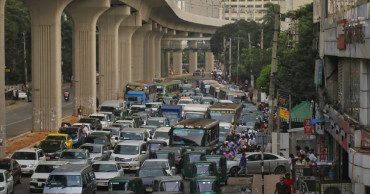air quality improves
As rain continues, Dhaka's air quality remains 'moderate'
Dhaka's air quality is ‘moderate’ this morning.
With an air quality index (AQI) score of 91 at 9:11 am, Dhaka ranked 12th on the list of cities worldwide with the worst air quality.
Saudi Arabia’s Riyadh, Indonesia’s Jakarta and Brazil’a Sao Paulo occupied the first three spots on the list, with AQI scores of 157, 155 and 134, respectively.
Thanks to rain, Dhaka's air quality 'moderate' this morning
An AQI between 51 and 100 is considered 'moderate', AQI between 101 and 150 is considered ‘unhealthy', and between 201 and 300 is said to be 'very unhealthy', while a reading of 301+ is considered 'hazardous', posing serious health risks to residents.
In Bangladesh, the AQI is based on five criteria pollutants -- Particulate Matter (PM10 and PM2.5), NO2, CO, SO2 and Ozone.
Dhaka has long been grappling with air pollution issues. Its air quality usually turns unhealthy in winter and improves during the monsoon.
Dhaka's air quality still in the 'moderate' range
Air pollution consistently ranks among the top risk factors for death and disability worldwide.
As per the World Health Organization (WHO), air pollution kills an estimated seven million people worldwide every year, largely as a result of increased mortality from stroke, heart disease, chronic obstructive pulmonary disease, lung cancer and acute respiratory infections.
Dhaka's air quality 'moderate' this morning
2 years ago
Dhaka's air quality remains 'moderate'
Dhaka's air quality continued to be in the ‘moderate’ zone on Saturday.
With an air quality index (AQI) score of 85 at 8.40am, the metropolis ranked 16th in the list of world cities with the worst air quality.
An AQI between 50 and 100 is considered ‘moderate’ with an acceptable air quality. However, there may be a moderate health concern for a very small number of people who are unusually sensitive to air pollution.
The United Arab Emirates' Dubai, Pakistan’s Lahore and Saudi Arabia’s Riyadh occupied the first three spots in the list, with AQI scores of 171, 152 and 151, respectively.
An AQI between 101 and 200 is considered 'unhealthy', particularly for sensitive groups.
Similarly, an AQI between 201 and 300 is said to be 'poor', while a reading of 301 to 400 is considered 'hazardous', posing serious health risks to residents.
In Bangladesh, the AQI is based on five criteria pollutants -- Particulate Matter (PM10 and PM2.5), NO2, CO, SO2 and Ozone.
Also read: Dhaka's air quality remains 'moderate'
Dhaka has long been grappling with air pollution issues. Its air quality usually turns unhealthy in winter and improves during the monsoon.
Air pollution consistently ranks among the top risk factors for death and disability worldwide. Breathing polluted air has long been recognised as increasing a person’s chances of developing a heart disease, chronic respiratory diseases, lung infections and cancer, according to several studies.
As per the World Health Organization (WHO), air pollution kills an estimated seven million people worldwide every year, largely as a result of increased mortality from stroke, heart disease, chronic obstructive pulmonary disease, lung cancer and acute respiratory infections.
3 years ago
Dhaka's air quality remains 'moderate'
Dhaka's air quality continued to be in the 'moderate' zone on Thursday, thanks to intermittent late monsoon showers for the past few days.
With an air quality index (AQI) score of 55 at 8.50 am, the metropolis ranked 38th in the list of world cities with the worst air quality.
An AQI between 50 and 100 is considered ‘moderate’ with an acceptable air quality. However, there may be a moderate health concern for a very small number of people who are unusually sensitive to air pollution.
Vietnam's Hanoi, Saudi Arabia’s Riyadh and the United Arab Emirates' Dubai occupied the first three spots in the list, with AQI scores of 158, 156 and 154, respectively.
An AQI between 101 and 200 is considered 'unhealthy', particularly for sensitive groups.
Similarly, an AQI between 201 and 300 is said to be 'poor', while a reading of 301 to 400 is considered 'hazardous', posing serious health risks to residents.
In Bangladesh, the AQI is based on five criteria pollutants -- Particulate Matter (PM10 and PM2.5), NO2, CO, SO2 and Ozone.
Also read: Dhaka's air quality remains 'unhealthy'
Dhaka has long been grappling with air pollution issues. Its air quality usually turns unhealthy in winter and improves during the monsoon.
Air pollution consistently ranks among the top risk factors for death and disability worldwide. Breathing polluted air has long been recognised as increasing a person’s chances of developing a heart disease, chronic respiratory diseases, lung infections and cancer, according to several studies.
As per the World Health Organization (WHO), air pollution kills an estimated seven million people worldwide every year, largely as a result of increased mortality from stroke, heart disease, chronic obstructive pulmonary disease, lung cancer and acute respiratory infections.
3 years ago
Dhaka's air quality improves
Dhaka's air quality has seen a marked improvement in the past 24 hours, all thanks to intermittent monsoon showers.
With an air quality index (AQI) score of 98 or 'moderate' at 9am on Saturday, the metropolis ranked 10th in the list of world cities with the worst air quality.
Saudi Arabia’s Riyadh, the United Arab Emirates' Dubai and Pakistan’s Lahore occupied the first three spots in the list, with AQI scores of 170, 160 and 156, respectively.
An AQI between 50 and 100 is considered ‘moderate’ with an acceptable air quality. However, there may be a moderate health concern for a very small number of people who are unusually sensitive to air pollution.
On the other hand, an AQI between 101 and 200 is considered 'unhealthy', particularly for sensitive groups.
Similarly, an AQI between 201 and 300 is said to be 'poor', while a reading of 301 to 400 is considered 'hazardous', posing serious health risks to residents.
AQI, an index for reporting daily air quality, is used by government agencies to inform people how clean or polluted the air of a certain city is, and what associated health effects might be a concern for them.
In Bangladesh, the AQI is based on five criteria pollutants -- Particulate Matter (PM10 and PM2.5), NO2, CO, SO2 and Ozone.
Read:Air quality remains 'moderate' in Dhaka
Dhaka has long been grappling with air pollution issues. Its air quality usually turns unhealthy during winter and improves during monsoon.
With the advent of winter, the city’s air quality starts deteriorating sharply due to the massive discharge of pollutant particles from construction works, rundown roads, brick kilns and other sources.
Air pollution consistently ranks among the top risk factors for death and disability worldwide. Breathing polluted air has long been recognised as increasing a person’s chances of developing heart disease, chronic respiratory diseases, lung infections and cancer, according to several studies.
As per the World Health Organization (WHO), air pollution kills an estimated seven million people worldwide every year, largely as a result of increased mortality from stroke, heart disease, chronic obstructive pulmonary disease, lung cancer and acute respiratory infections.
3 years ago
Air quality remains 'moderate' in Dhaka
Dhaka's air quality continues to be in the 'moderate' zone, all thanks to intermittent monsoon showers.
Read: Global pollution kills 9 million people a year, study finds
With an air quality index (AQI) score of 50 at 9.30 am on Thursday, the metropolis ranked 47th in the list of world cities with the worst air quality.
Pakistan's Lahore, Iran’s Tehran and Chile’s Santiago occupied the first three spots in the list, with AQI scores of 161, 148 and 127 respectively.
An AQI between 50 and 100 is considered ‘moderate’ with an acceptable air quality. However, there may be a moderate health concern for a very small number of people who are unusually sensitive to air pollution.
An AQI between 101 and 200 is considered 'unhealthy', particularly for sensitive groups.
Similarly, an AQI between 201 and 300 is said to be 'poor', while a reading of 301 to 400 is considered 'hazardous', posing serious health risks to residents.
AQI, an index for reporting daily air quality, is used by government agencies to inform people how clean or polluted the air of a certain city is, and what associated health effects might be a concern for them.
In Bangladesh, the AQI is based on five criteria pollutants -- Particulate Matter (PM10 and PM2.5), NO2, CO, SO2 and Ozone.
Dhaka has long been grappling with air pollution issues. Its air quality usually turns unhealthy during winter and improves during monsoon.
With the advent of winter, the city’s air quality starts deteriorating sharply due to the massive discharge of pollutant particles from construction works, rundown roads, brick kilns and other sources.
Air pollution consistently ranks among the top risk factors for death and disability worldwide. Breathing polluted air has long been recognised as increasing a person’s chances of developing heart disease, chronic respiratory diseases, lung infections and cancer, according to several studies.
As per the World Health Organization (WHO), air pollution kills an estimated seven million people worldwide every year, largely as a result of increased mortality from stroke, heart disease, chronic obstructive pulmonary disease, lung cancer and acute respiratory infections.
3 years ago
Dhaka’s air quality now 'moderate'
Dhaka's air quality witnessed a marked improvement on Sunday morning, after remaining ‘unhealthy’ a day before.
With an air quality index (AQI) score of 57, recorded at 10:11am, the metropolis ranked 38th in the list of world cities with the worst air quality.
An AQI between 50 and 100 is considered ‘moderate’ with an acceptable air quality. However, there may be a moderate health concern for a very small number of people who are unusually sensitive to air pollution.
Chile’s Santiago, Saudi Arabia’s Riyadh and Iran’s Tehran occupied the first three spots in the list, with AQI scores of 166, 154 and 151, respectively.
An AQI between 101 and 200 is considered 'unhealthy', particularly for sensitive groups.
Similarly, an AQI between 201 and 300 is said to be 'poor', while a reading of 301 to 400 is considered 'hazardous', posing serious health risks to residents.
AQI, an index for reporting daily air quality, is used by government agencies to inform people how clean or polluted the air of a certain city is, and what associated health effects might be a concern for them.
In Bangladesh, the AQI is based on five criteria pollutants -- Particulate Matter (PM10 and PM2.5), NO2, CO, SO2 and Ozone.
Dhaka has long been grappling with air pollution issues. Its air quality usually turns unhealthy during winter and improves during monsoon.
A report by the Department of Environment (DoE) and the World Bank in March 2019 pointed out that the three main sources of air pollution in Dhaka "are brick kilns, fumes from vehicles and dust from construction sites".
With the advent of winter, the city’s air quality starts deteriorating sharply due to the massive discharge of pollutant particles from construction works, rundown roads, brick kilns and other sources.
Also read: Dhaka’s air quality turns 'unhealthy' again
Air pollution consistently ranks among the top risk factors for death and disability worldwide. Breathing polluted air has long been recognised as increasing a person’s chances of developing heart disease, chronic respiratory diseases, lung infections and cancer, according to several studies.
As per the World Health Organization (WHO), air pollution kills an estimated seven million people worldwide every year, largely as a result of increased mortality from stroke, heart disease, chronic obstructive pulmonary disease, lung cancer and acute respiratory infections.
3 years ago
Dhaka’s air quality remains ‘moderate’
Dhaka's air quality continues to be in the 'moderate' zone Sunday morning.
With an air quality index (AQI) score of 60 at 10:15 am, the metropolis ranked 21st in the list of world cities with the worst air quality.
An AQI between 50 and 100 is considered ‘moderate’ with an acceptable air quality. However, there may be a moderate health concern for a very small number of people who are unusually sensitive to air pollution.
Kuwait’s Kuwait City, the United Arab Emirates’s Dubai and Chile’s Santiago occupied the first three spots in the list, with AQI scores of 312, 156, 148, respectively.
An AQI between 101 and 200 is considered 'unhealthy', particularly for sensitive groups.
Similarly, an AQI between 201 and 300 is said to be 'poor', while a reading of 301 to 400 is considered 'hazardous', posing serious health risks to residents.
AQI, an index for reporting daily air quality, is used by government agencies to inform people how clean or polluted the air of a certain city is, and what associated health effects might be a concern for them.
In Bangladesh, the AQI is based on five criteria pollutants -- Particulate Matter (PM10 and PM2.5), NO2, CO, SO2 and Ozone.
Dhaka has long been grappling with air pollution issues. Its air quality usually turns unhealthy in winter and improves during the monsoon.
A report by the Department of Environment (DoE) and the World Bank in March 2019 pointed out that the three main sources of air pollution in Dhaka "are brick kilns, fumes from vehicles and dust from construction sites".
With the advent of winter, the city’s air quality starts deteriorating sharply due to the massive discharge of pollutant particles from construction work, rundown roads, brick kilns and other sources.
Air pollution consistently ranks among the top risk factors for death and disability worldwide. Breathing polluted air has long been recognised as increasing a person’s chances of developing a heart disease, chronic respiratory diseases, lung infections and cancer, according to several studies.
Also read: Dhaka's air quality turns 'moderate'
As per the World Health Organization (WHO), air pollution kills an estimated seven million people worldwide every year, largely as a result of increased mortality from stroke, heart disease, chronic obstructive pulmonary disease, lung cancer and acute respiratory infections.
3 years ago
Dhaka’s air quality improves
The onset of monsoon over Bangladesh has brought some good news for the residents of Dhaka gasping for clean air.
The air quality of the densely populated metropolis has now improved from 'unhealthy' to ‘moderate’ category.
With an air quality index (AQI) score of 76 at 12:15 pm on Thursday, Dhaka ranked 17th on the list of world cities with the worst air quality.
Saudi Arabia’s Riyadh, Chile’s Santiago, and South Korea’s Busan occupied the first, second and third spots, with AQI scores of 151, 141, and 134, respectively, in the list.
An AQI between 50 and 100 is considered ‘moderate’ with an acceptable air quality however; there may be a moderate health concern for a very small number of people who are unusually sensitive to air pollution.
An AQI between 151and 200 is considered 'unhealthy' for everyone and members of sensitive groups may experience more serious health effects.
Read Also: Operate mobile court to stop air pollution: HC
Similarly, an AQI between 201 and 300 is said to be 'poor', while a reading of 301 to 400 is considered 'hazardous', posing serious health risks to residents.
AQI, an index for reporting daily air quality, is used by government agencies to inform people how clean or polluted the air of a certain city is, and what associated health effects might be a concern for them.
In Bangladesh, the AQI is based on five criteria pollutants -- Particulate Matter (PM10 and PM2.5), NO2, CO, SO2 and Ozone.
Dhaka has long been grappling with air pollution issues. Its air quality usually turns unhealthy in winter and improves during the monsoon.
Read Also: Dhaka’s air unhealthy for sensitive groups
A report by the Department of Environment (DoE) and the World Bank in March 2019 pointed out that the three main sources of air pollution in Dhaka "are brick kilns, fumes from vehicles and dust from construction sites".
With the advent of winter, the city’s air quality starts deteriorating sharply due to the massive discharge of pollutant particles from construction work, rundown roads, brick kilns and other sources.
Air pollution consistently ranks among the top risk factors for death and disability worldwide. Breathing polluted air has long been recognised as increasing a person’s chances of developing a heart disease, chronic respiratory diseases, lung infections and cancer, according to several studies.
As per the World Health Organization (WHO), air pollution kills an estimated seven million people worldwide every year, largely as a result of increased mortality from stroke, heart disease, chronic obstructive pulmonary disease, lung cancer and acute respiratory infections.
3 years ago
Dhaka’s air quality improves
Bangladesh’s capital Dhaka saw a marked improvement in air quality on Thursday.
With an air quality index (AQI) score of 75 at 8.52am, the metropolis ranked 26th in the list of world cities with the worst air quality. Dhaka's AQI was categorised as ‘moderate’.
Russia’s Krasnoyarsk, India’s Delhi and China’s Chengdu occupied the first three spots in the list, with AQI scores of 182, 168 and 160, respectively.
An AQI between 101 and 200 is considered 'unhealthy', particularly for sensitive groups.
Similarly, an AQI between 201 and 300 is said to be 'poor', while a reading of 301 to 400 is considered 'hazardous', posing serious health risks to residents.
Also Read - Dhaka’s air quality improves significantly
AQI, an index for reporting daily air quality, is used by government agencies to inform people how clean or polluted the air of a certain city is, and what associated health effects might be a concern for them.
In Bangladesh, the AQI is based on five criteria pollutants -- Particulate Matter (PM10 and PM2.5), NO2, CO, SO2 and Ozone.
Dhaka has long been grappling with air pollution issues. Its air quality usually turns unhealthy in winter and improves during the monsoon.
A report by the Department of Environment (DoE) and the World Bank in March 2019 pointed out that the three main sources of air pollution in Dhaka "are brick kilns, fumes from vehicles and dust from construction sites".
With the advent of winter, the city’s air quality starts deteriorating sharply due to the massive discharge of pollutant particles from construction work, rundown roads, brick kilns and other sources.
Also read: Dhaka breathes better as its air quality improves
Air pollution consistently ranks among the top risk factors for death and disability worldwide. Breathing polluted air has long been recognised as increasing a person’s chances of developing a heart disease, chronic respiratory diseases, lung infections and cancer, according to several studies.
As per the World Health Organization (WHO), air pollution kills an estimated seven million people worldwide every year, largely as a result of increased mortality from stroke, heart disease, chronic obstructive pulmonary disease, lung cancer and acute respiratory infections.
3 years ago
AQI: Dhaka’s air quality improves
The air quality of Bangladesh’s capital Dhaka showed signs of improvement on Tuesday morning.
Dhaka’s air was catagorised as ‘moderate’ on Tuesday morning and it ranked 12th position of the worst polluted cities in the world.
The megacity had an AQI score of 86 at 09:04am.
When the AQI remains between 51 and 100, the air quality is acceptable.
However, there may be a risk for some people, particularly those who are unusually sensitive to air pollution.
United Arab Emirates’ Dubai, South Africa’s Johannesburg and India’s Delhi occupied the first three spots in the list of cities with the worst air quality with AQI scores of 187, 186 and 124 respectively.
The AQI, an index for reporting daily air quality, informs people how clean or polluted the air of a certain city is, and what associated health effects might be a concern for them.
In Bangladesh, the AQI is based on five criteria pollutants – Particulate Matter (PM10 and PM2.5), NO2, CO, SO2, and Ozone (O3).
Bangladesh has a subtropical monsoon climate characterized by wide seasonal variations in rainfall, high temperatures and humidity.
Dhaka’s air starts getting fresh when rainfall begins from mid-June. The air remains mostly acceptable during monsoon from June to October.
Dhaka has long been grappling with air pollution. Its air quality usually improves during monsoon.
5 years ago









.jpg)








